Last summer brought us the superb dog-day cicada, Neotibicen superbus and its nostalgic, resonating song.
Another Texas songster is filling the night air this summer with decibel-alarming pitch: the giant cicada, Quesada gigas, the widest ranging cicada in the Western Hemisphere — and quite possibly, the loudest insect in Texas.
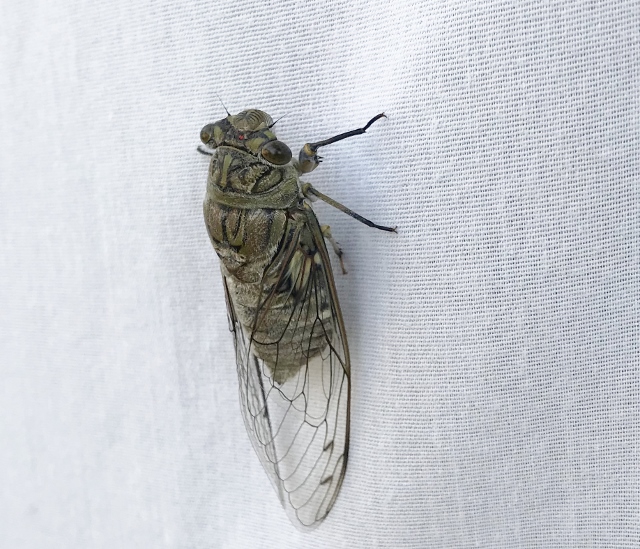
The giant cicada’s northern most range is the lower half of Texas and points beyond as far south as Argentina, as well as Belize, Bolivia, Brazil, Colombia, Costa Rica, Ecuador, Guatemala, Guyana, Mexico, Panama, Paraguay, Peru, Tobago, Trinidad, and Venezuela.
There are two categories of cicadas, those known as annual, and others called periodical. Our giant cicada is an annual, those cicadas that emerge during the height of summer. The term annual refers to the fact that these cicadas are seen every year; their underground nymph stage is one to two years or more which staggers their annual emergence.
Periodical cicadas, on the other hand, are those that spend 13 or 17 years below ground, depending on the species in nymph stage, and emerge all at once in great masses. We don’t have to worry about those, here in the Valley; they just barely touch the northeastern counties of Texas that border Oklahoma, along the Red River.
Periodical cicadas are about one and one-half inches long, have reddish colored eyes, black bodies and orange-veined wings. Periodical cicadas are found in the eastern and Midwestern areas of the United States.
Wikipedia has an interesting page about periodical cicadas and a colorful map (scroll down at the link): https://en.wikipedia.org/wiki/Periodical_cicadas for a map of Active Periodical Cicada Broods of the United States
The broods have nicknames; the map reflects each brood’s next emergence, if experiencing the phenomena is on your bucket list. I experienced such an event in the early 1990s in Washington, D.C.; it was quite something — cicadas hanging from shrubs like ornaments on an overly-decorated Christmas tree. Enough about those periodical cicadas.
Annual cicadas, on the other hand, are very much observable here in the summer. You most likely don’t have to leave the confines of your own yard to see or hear them. If nothing else, you may see evidence of what they’ve left behind — their exoskeleton — clinging to a tree trunk or wall.
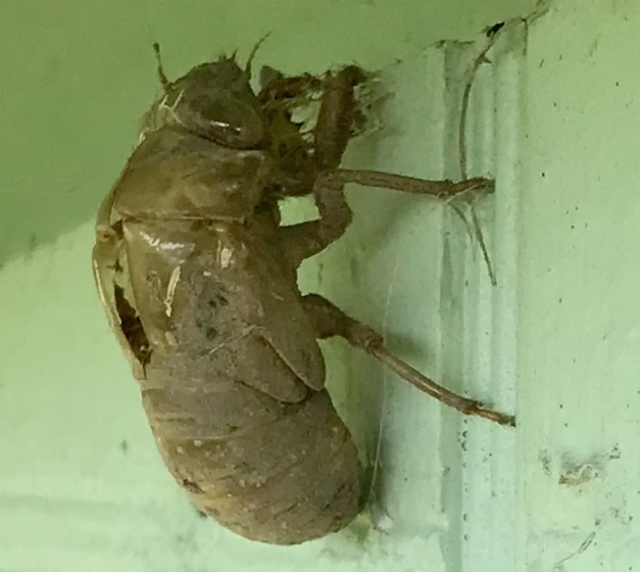
There are 50 some cicada species throughout Texas. I’ve documented four on our property, including last year’s beauty: the superb dog-day, Neotibicen superbus.
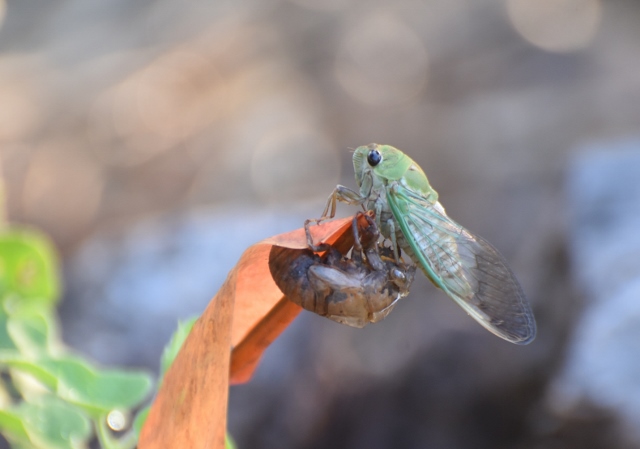
Annual cicadas that have visited my moth sheet set up this past week vary in size from about three quarters of an inch long, the little mesquite cicada, Pacarina puella; the one and one-quarter inch long scrub cicada, Diceroprocta delicate; and the nearly two-and one-half inches long giant cicada. If you haven’t read about the moth-attracting set ups, see South Texas Border Chapter, Texas Master Naturalist’s mothing blog: https://www.stbctmn.org/post/mothing
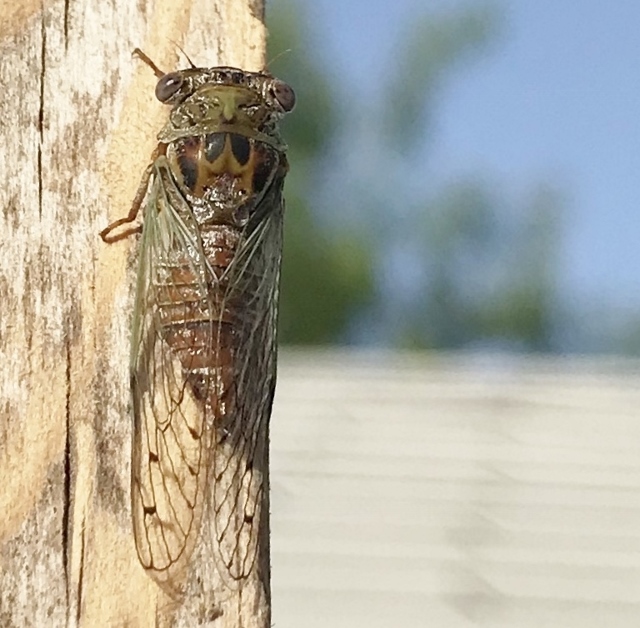
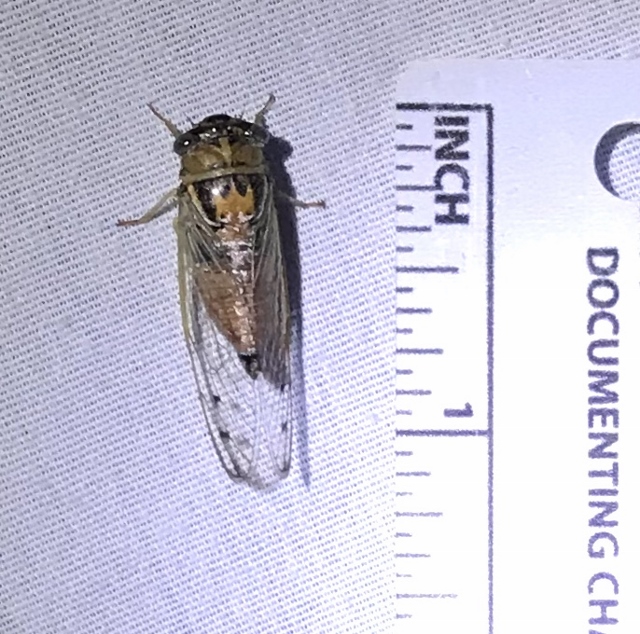
Annual cicadas generally have green or brownish bodies and green- to bronze-veined wings. The upper body markings are such as to camouflage the cicada to its environment in artful combinations of black, green and brown patterns. Most annual cicadas have brown eyes and brown to green pronotal collar color.
The pronotal collar is one of three distinguishing identifying marks on a cicada’s anatomy. If you consider the sectional areas directly behind the eyes beginning with the first segment, that is the pronotum. The second area, a relatively thin lateral strip, is the pronotal collar; the larger, patterned area below the pronotal collar is called the mesonotum. The distinctive pattern and design of the mesonotum is especially helpful in species identification, for those interested in putting names to critters.
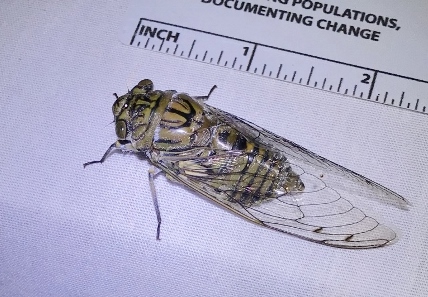
This summer’s giant cicadas can certainly be identified by sound alone — it’s that shrill, near-deafening shriek that has often been likened to mechanical devices — those devices that generally come with a warning to wear ear protection! The giant cicada song has been described as ear-piercing sirens, alarms and train whistles.
In nature, that frightful, conversation-cancelling noise is the mating call — belted out only by male cicadas. Each species has its own distinctive song that only attracts females of its own kind, thus allowing several different species to coexist, according to animals.howstuffowrks.com.
To hear a recording of a giant cicada, check out this web site:
http://texasento.net/Cicada.htm
One source mentioned that there have been 11 species of cicadas found in the Rio Grande Valley. Let us know if you’ve documented more than those described here!
For more stories about cicadas type in the word cicadas in the chapter’s article archive page search box on the website www.rgvctmn.org
Another excellent and well researched post! Your photos are amazing. I’ve been working on a cicada poem; actually two. Who knows when I will get them completed, but when I do, I will be sure to share with you. Keep on, friend!
Thank you, Elizabeth. I can’t wait to read your cicada poems! How exciting!
Even as I’m reading this post, I can hear them outside my air-conditioned, well insulated house! I had to chuckle as I became aware of the sound when I starting reading the first sentence in your post. Otherwise, I think that their sound had become “white noise”. Thank you for the great details of the cicada, along with the great photos.
Oh, wow! I can’t think of a better compliment than your very reading my words made the sounds come alive! HA! That’s a cool story!
Thank you for the interesting information about Cicadas. I had a structure built to direct water from a large irrigation pipe towards the front of the yard to irrigate the citrus instead of running down the back yard into the Resaca. I put various branches, leaves, coffee grounds, etc. to make compost in the structure. As I was digging up some compost I came across 2 large larva. At first I thought it was something that I didn’t want near my plants and tossed one out but the next one looked like a Cicada larvae. So I put both of them back where I found them. If I find the picture I will post it.
It’s hard to know what to do when we find something we aren’t sure about. Good action, to put them back!